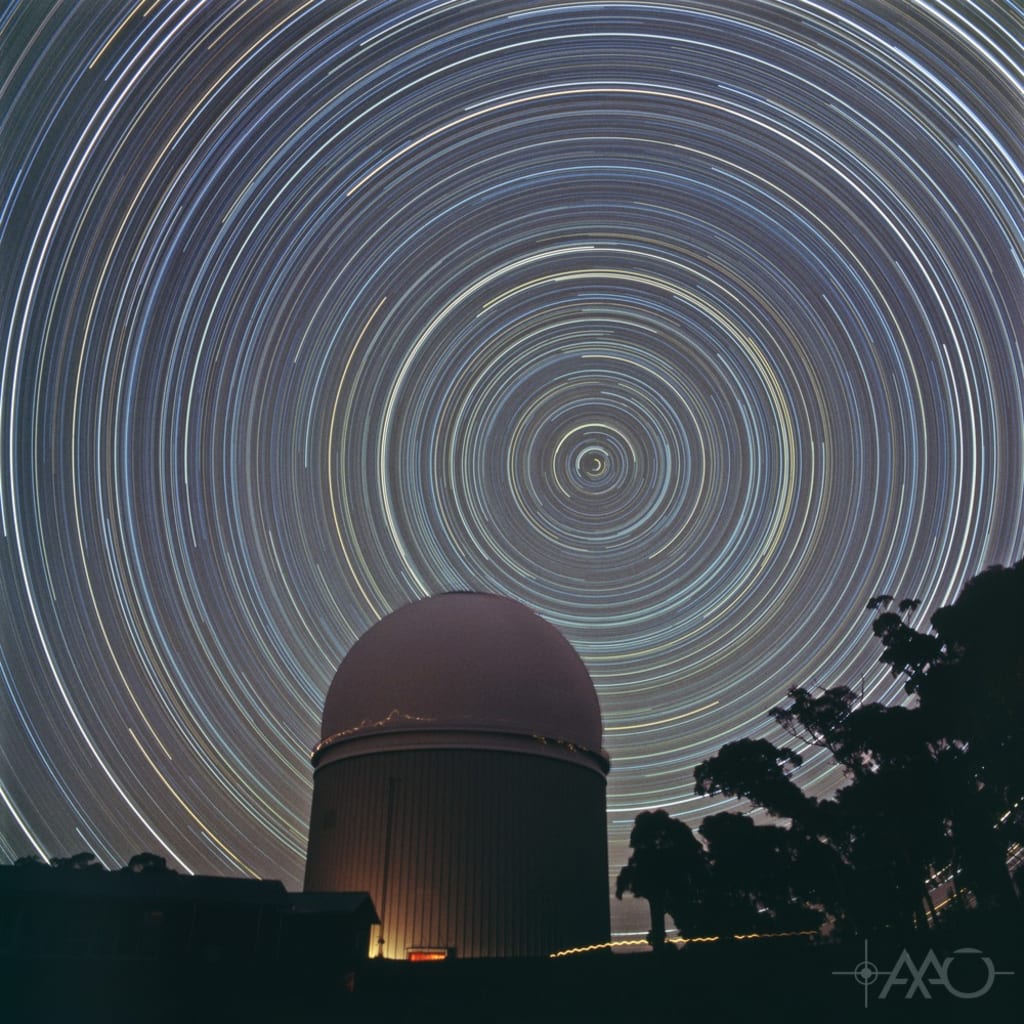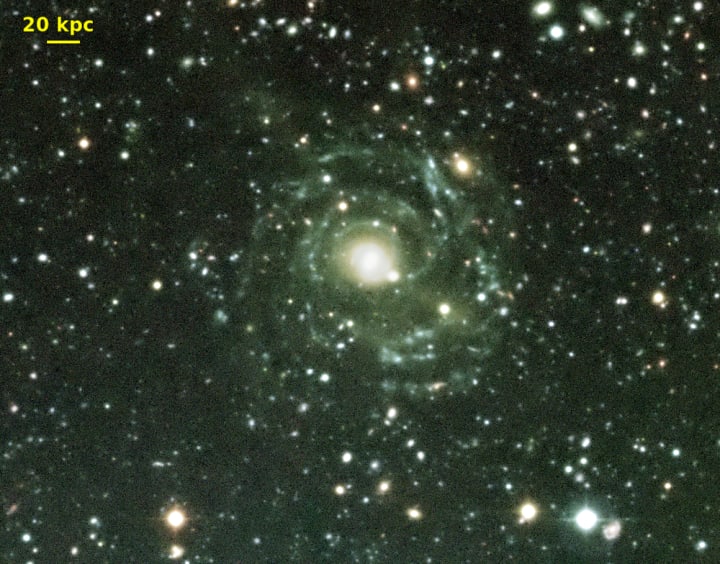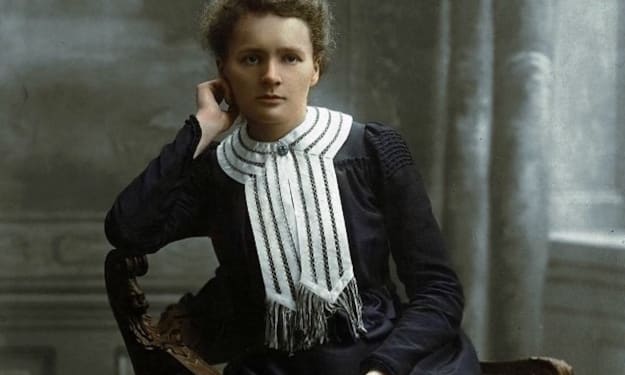The Man Who Coloured the Cosmos
Once, all deep space photography was black-and-white. But when a chemist developed a new technique, colour exploded from the heavens.

FEW PEOPLE have a building named after them, much less an asteroid, a planet or a star. But a whole galaxy? Filled with billions and billions of stars? That’s what happened to David Malin, one of Australia’s most celebrated astronomers and one the world’s foremost astronomical photographers. And it happened by accident.
In 1976, he was collecting new images for a book by fellow astronomers at the then spanking new Anglo-Australian Observatory in Siding Spring, near Coonabarabran, in outback New South Wales state.
“I started playing with these plates from the UK Schmidt Telescope in the darkroom,” he recalls. Trialling a technique he had only just invented — one that extracted more of the faint light from stars — he noticed something unusual: “A galaxy near the Virgo cluster had a funny thing sticking out of it. I didn’t know what it was, or even if it was meaningful.”
It looked like a jet sticking out of Messier 89, a well-known elliptical galaxy in the constellation Virgo. His fellow astronomers were surprised—the region had been well surveyed, so the object was unexpected. He soon found himself one of the authors of a paper in the peer-reviewed scientific publication, Astronomical Journal— his first.
This made Malin rather fond of the constellation. Years later, while re-photographing the same region at higher resolutions, as part of a survey of the faintest galaxies, he spotted another strange blob with wisps around in one of the images. He planted an exclamation mark next to it on the photographic plate, and sent it to his colleagues in the United States.


His American collaborators were flabbergasted — they had never seen anything quite like it before. Later, when they pointed a radio telescope at the mysterious new object, they were astonished to find it was not only a completely new type of galaxy, it was also much, much further away — far beyond the Virgo cluster…and very, very large.
“They were very enthusiastic about it,” says Malin in his characteristically modest way. “In fact, we ended up producing another paper, with me as third author. I was very happy with that, particularly when they named the galaxy ‘Malin 1’ in the paper.”
Malin-1 is arguably the biggest spiral galaxy ever discovered — more than three times the size of our own Milky Way, itself rather large. Known as a giant low surface-brightness spiral galaxy, it is located 1.19 billion light-years away, and has diameter of some 650,000 light-years. Despite years of searching since, only three more of these faint and elusive conglomerations of stars have ever been seen.
Not bad for someone who wasn’t even an astronomer. In fact, Malin had begun his working life in England as a chemist.
AFTER GRADUATING from a technical college in Lancashire, Malin landed a job in Manchester working as a laboratory assistant for the giant chemical company, Ciba-Geigy. Although he’d taken apart his grandparents’ box camera at the age of 6, and had played with lenses and magnifying glasses as a child, it wasn’t until he took a holiday in Paris in his early twenties that he acquired a passion for photography.
“To a kid from the grimy suburbs of north England, Paris was just a mind-blowing experience,” he recalls. “I was pointing this borrowed camera everywhere … click, click, click.”


He returned with a dozen rolls of black-and-white film he couldn’t afford to develop, so friends at Ciba-Geigy’s labs showed him how to do it himself. “They showed me how to mix the chemicals to make developer, how to use an enlarger which was hiding in some dark corner of the company. And suddenly, my French holiday was re-appearing in front of my eyes.
“This was a magical experience for me, because I was not only able to recreate the images I made in Paris, but fiddle with them, get them to say what I felt when I took the picture. I was able express something creative.”
He was so overwhelmed by the beauty of the process he didn’t notice a Ciba-Geigy executive stumble upon him developing his holiday snaps on company time. “Now, the right thing to do was to fire me,” says Malin. “But he went to my boss and said, ‘This man clearly has some photographic interest, you should encourage him in that direction’. And my boss did: he gave me a microscope and some crystals and said he wanted pictures of them.”
At the time, industrial chemists were becoming increasingly interested in how chemicals like pigments and additives behaved at a microscopic level. Malin began to conduct microscopic studies of common chemical problems. His work proved so successful that within a few years he was heading a research team of four people, using fancy new microscopes and x-ray machines.


But despite being widely lauded by other researchers and advancing several company projects with his discoveries over the 18 years he worked there, the company refused to officially make him head of the laboratory — which would have meant a much-needed pay rise. “It was very British,” Malin says dryly. “I didn’t have the right paper qualifications.”
Now in his mid-30s, married to an Australian and with three children and a mortgage on a country cottage in Cheshire, he realised his career could advance no further.
One day, reading the international science journal Nature, he spied a job advertisement for someone to run a photographic laboratory at a new observatory in Australia. It was 1975, and the Anglo-Australian Observatory (AAO) — the country’s pre-eminent astronomical facility — had just opened its doors. “This job just seemed the bee’s knees,” recalls Malin.
He applied, and soon enough had moved to Australia. “I jumped in at the deep end, because I didn’t know much about astronomy when I joined. But everyone was new, everything was new. If you wanted a cloth to wipe something, you had to go out and buy one. It was a big adventure — so falling into the deep end was a really good way to go. If you survive, you learn to swim very effectively and quite quickly.”
ASTRONOMERS ARE FOREVER trying to extract more information, in the form of light, from very faint objects in deep space. Right into the 1990s, they used large glass plates with special photographic emulsions coated on them, as these were more sensitive than film.
Using his training in chemistry, Malin began to experiment with different techniques to ‘hypersensitise’ the plates, baking them to remove the oxygen and water, and then soaking them in hydrogen gas for a few hours, all of which made the emulsion more sensitive to the dim and distant light of stars.


It was hit and miss at first, but once he and his colleagues at the UK Schmidt Telescope in Siding Spring had hit on the winning formula, it improved the sensitivity of the plates to faint light up 30 times over. Exposures of faraway galaxies that might take most of a night’s observing could be done in an hour or two.
This allowed several plates of an object to be taken in one session, and then the results of the copying technique could be photgraphically added together in perfect register, revealing even the faintest objects. The ability to add together images led directly to a way of making colour images of delicate and distant objects.
Malin was inspired by the early work of James Clarke Maxwell, who in 1861 was the first to develop a method of colour photography using black-and-white plates with red, green and blue filters, which were then merged together to create colour images. So Malin began tinkering with this antiquated process, and developed a new way of extracting even more detail, as well as colour, from the same astronomical plates.
The results were stunning, and soon, the astronomical world was buzzing with talk of the AAO’s fantastic new colour images of deep space. There were fine wisps of pink clouds energised by the solar wind of distant stars, clouds of electric blue around young stars — colours that had hitherto been invisible to astronomers. Malin published several scientific papers on the new photographic techniques, which were dubbed ‘malinisation’ and quickly adopted around the world.
Suddenly, Malin — a humble chemist — was being asked to collaborate with big-name astronomers from all around the world. “Often astronomers said to me, ‘I know this object, I’ve observed it and I know the spectrum, but I never thought it looked like that’,” chuckles Malin. “Colour is a very powerful diagnostic, especially for astronomers, and they had never seen many of these objects in colour before.”
Along the way, Malin accidentally discovered another new class of galaxies, now known as ‘shell galaxies’. These fuzzy, seemingly featureless elliptical galaxies actually have unexpected, sharp-edged but still faint features associated with them — believed to be the marks left by massive collisions between galaxies billions of years ago. And, just for good measure, he has also had an asteroid named after him: 4766 Malin, a 7.4 km rock with an orbital period of 1,524 days around the Sun.
So at what point did Malin actually become an astronomer? “That’s a good question, nobody has asked me that before,” Malin muses. “I think of an astronomer as somebody who has worked many years, got a first-class degree, a masters and spent four or five years on a doctorate. I haven’t had that education, and there are many areas where my knowledge is seriously lacking.
“On the other hand, I have made some useful scientific discoveries based on what little knowledge I have. So I’m not an astronomer out of the standard box. I’m not a complete astronomer, but I have made a contribution.”
For someone who professes to be an incomplete astronomer, David Malin has had a huge impact on the field. He published more than 120 scientific papers on astronomy and photography in his 25 years with the Anglo-Australian Observatory, renamed the Australian Astronomical Observatory in 2010 following the end of a 40-year bilateral agreement between Britain and Australia.

Ironically, having brought colour to the cosmos for the first time ever in the 1970s, his technique was usurped by computers beginning in 1992 — in particular, by charge-coupled devices (CCDs). The basis of digital photography, CCDs became cheap and powerful enough to be used in astronomy and—unlike photographic plates — could be rapidly reproduced indefinitely without any loss of image quality.
“They’re much more efficient: they collect over 80% of the photons, whereas photographic plates used to catch 5% at best,” says Malin.
Nevertheless, it took a while to make them match the quality of plates, he recalls: “The plates are big, which meant they fit nicely into the focal plane of a large telescope, which can be 25 cm square. CCD chips are tiny things — the size of a postage stamp — so you have to array them together and there are gaps between them, so you have to ‘shift and shoot’ to fill in all the gaps. It’s fiddly, but very effective.
“They were very expensive too, but when mass production of digital cameras began, the standards improved enormously,” he adds.
Was he disappointed his reign was so short? “I was delighted,” he says. “Anything that allowed us to capture the limited photons that come down telescopes is fantastic. We knew they would improve the science, and by golly, they did.”
CCDs did, however, take away some of the poetry of deep space colour imagery. “It made astrophotography a purely technical process, whereas before there were some ‘arty farty’ skills involved — how long you process things, and how you extract real colours from a plate.”
Colour is an issue that’s often misunderstood outside astronomy. That’s because we tend to associate a colour like red with heat and a colour like blue with cold because of our Earthly experience. This does not apply to stars which are ‘blackbodies’, objects which do not reflect light, nor do they allow light to pass through them.
So, which colour star — red or blue — is actually hotter? The colour of a star is a function of its surface temperature, which range from a few thousand degrees up to 40,000˚C. The hottest stars appear blue or blue-white, whereas the coolest stars are red. The best way to extract true colours from the stars is to calibrate them to known temperatures.

“Each star has a very specific and continuous spectrum,” explains Malin. “So if you know what the blackbody temperature is in any particular field of view, that’s your calibrator, and you use that to get the colour balance right.
“When people point their digital camera at the sky at night, it makes the sky blue — which it isn’t, it’s more greenish,” he adds. “But the camera doesn’t know about blackbody colours, so it always makes the Milky Way look blue or magenta, when it’s actually a kind of messy yellow. The truth is, our eyes are not sensitive enough to see the real colours of the sky. Cameras can, but they have to be calibrated right.”
In 2000, Malin was awarded the Lennart Nilsson Award for his achievements in astronomical photography, a prize given by the Karolinska Institute of Sweden, the same organisation that annually bestows the Nobel Prize in Physiology or Medicine.
The following year, he retired from the AAO — the same year the David Malin Awards were founded, an annual astrophotography competition created by John Sarkissian, the operations scientist at the Parkes Radio Observatory — part of the CSIRO, Australia’s national science agency. Malin is one of the judges, and the winners from each category become part of an exhibition that tours Australia every year.
Apart from the awards, he’s written or co-written 12 books, among them Ancient Light, A Portrait of the Universe and Heaven & Earth: Unseen by the Naked Eye; while a collection of his images have become artworks, touring art galleries in Australia, Britain, Sweden and the United States.
He remains an Adjunct Professor of Scientific Photography at RMIT University in Melbourne, and has continued to curate the hundreds of spectacular colour images he created over a quarter-century of looking at the night sky … and bringing colour to a cosmos that was once strictly black and white.
Like this story? Please click the ♥︎ below, or send me a tip. And thanks 😊
About the Creator
Wilson da Silva
Wilson da Silva is a science journalist in Sydney | www.wilsondasilva.com | https://bit.ly/3kIF1SO






Comments
There are no comments for this story
Be the first to respond and start the conversation.